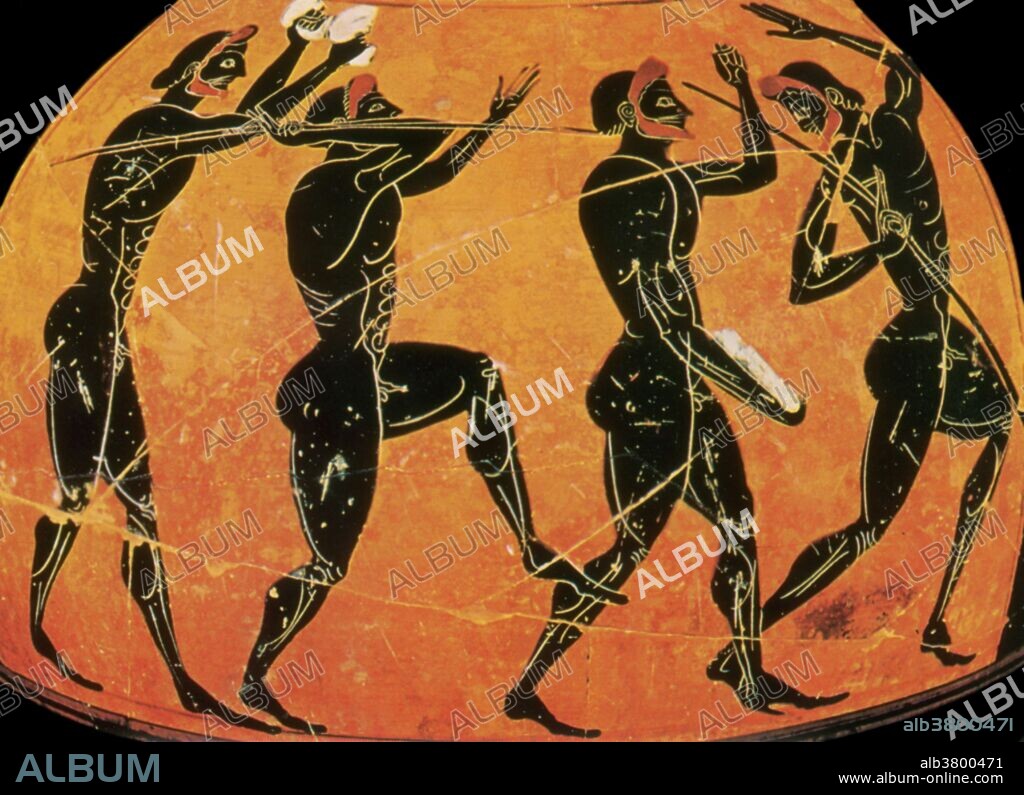alb3800471
Olympic Games, Pentathlon, Black-Figure Pottery

|
Ajouter à une autre Lightbox |
|
Ajouter à une autre Lightbox |



Avez-vous déjà un compte? S'identifier
Vous n'avez pas de compte ? S'inscrire
Acheter cette image.
Sélectionnez l'usage:

Titre:
Olympic Games, Pentathlon, Black-Figure Pottery
Légende:
Traduction automatique: Le pentathlon olympique antique était une compétition sportive. Cinq épreuves ont été disputées sur une journée, en commençant par le stadion (course à pied), suivi du lancer du javelot, du lancer du disque, du saut en longueur et en terminant par la lutte. Les Jeux Olympiques étaient une série de compétitions sportives entre représentants des cités-États et l'un des Jeux panhelléniques de la Grèce antique. Ils étaient célébrés en l'honneur de Zeus et les Grecs leur donnaient une origine mythologique. Les jeux avaient lieu tous les quatre ans, ou olympiade, qui sont devenues une unité de temps dans les chronologies historiques. Les principales épreuves de chacun des jeux étaient les courses de chars, la lutte, la boxe, le pancrace, le stade et diverses autres courses à pied, ainsi que le pentathlon (lutte, stade, saut en longueur, lancer du javelot et lancer du disque). À l'exception de la course de chars, tous les événements se sont déroulés nus. La peinture sur poterie à figures noires, également connue sous le nom de style à figures noires ou céramique à figures noires, est l'un des styles de peinture sur vases grecs antiques. Des figures et des ornements étaient peints sur le corps du navire en utilisant des formes et des couleurs rappelant des silhouettes.
The Ancient Olympic pentathlon was an athletic contest. Five events were contested over one day, starting with the stadion (foot race) followed by the javelin throw, discus throw, long jump, and ending with wrestling. The Olympic Games were a series of athletic competitions among representatives of city-states and one of the Panhellenic Games of Ancient Greece. They were held in honor of Zeus, and the Greeks gave them a mythological origin. The games were held every four years, or olympiad, which became a unit of time in historical chronologies. The main events at each of the games were chariot racing, wrestling, boxing, pankration, stadion and various other foot races, and the pentathlon (wrestling, stadion, long jump, javelin throw, and discus throw). Except for the chariot race, all the events were performed nude. Black-figure pottery painting, also known as the black-figure style or black-figure ceramic is one of the styles of painting on antique Greek vases. Figures and ornaments were painted on the body of the vessel using shapes and colors reminiscent of silhouettes.
Crédit:
Album / Science Source / NYPL
Autorisations:
Modèle: Non - Propriété: Non
Questions sur les droits?
Questions sur les droits?
Taille de l'image:
4350 x 3153 px | 39.2 MB
Taille d'impression:
36.8 x 26.7 cm | 14.5 x 10.5 in (300 dpi)
Mots clés:
ARCHÉLOGIE • ARCHEOLOGIE • ARCHÉOLOLOGIE • ATHLETE (ATHLETISME) • ATHLETE • ATHLETES • DÉNUDÉ • DISQUE • GRECE • HOMME • NU • NUS • PENTATHLON • SAUTER • SILHOUETTE • SPORT • SPORTIVE
 Pinterest
Pinterest Twitter
Twitter Facebook
Facebook Copier le lien
Copier le lien Email
Email
